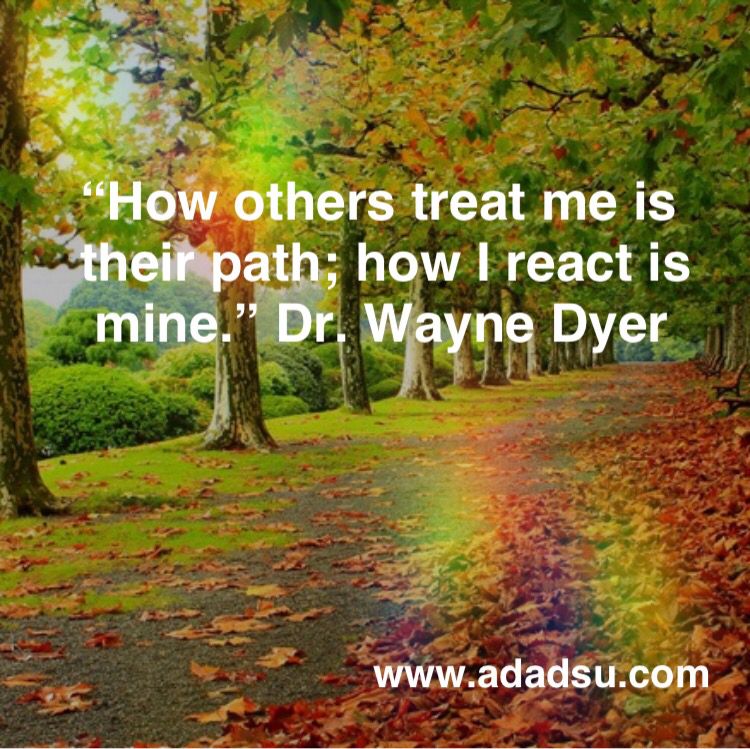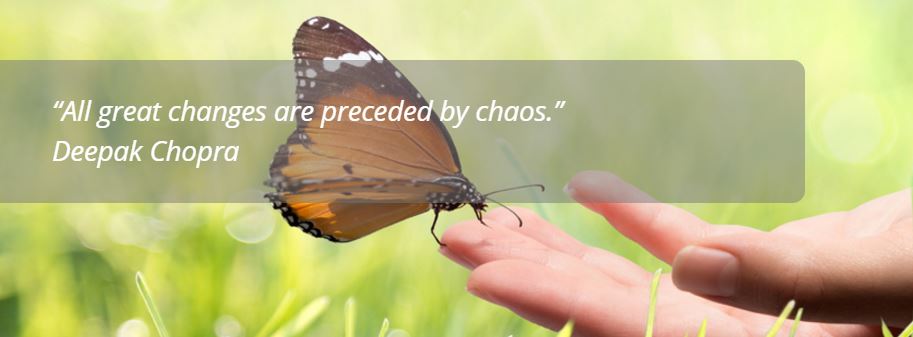Written by Lara Just – March 2018…
I have chosen the quote in the image below for this blog out of two reasons. First, we cannot control how other people may treat us or how other people react to us, even when we think we have shown our best intentions. Second, we can only control how we react to others and how we chose to feel about it.
As psychologist Susan David says so aptly in her talk about emotional agility (see our eNews on Emotional Agility): ‘we own our emotions, they don’t own us’. Well that sounds easier said than done – doesn’t it!
Sometimes it may feel that ‘we just can’t help it’ and we are in fact controlled by them. However, we do have a choice to breathe, stop and feel, and then make a more conscious decision about how to react.
Sometimes it may be better to walk away and let it go when we feel that there is no meeting point – to agree to disagree. Other times it feels somewhat important to assert ourselves, to put our point across, to stake out our territory, and to want to prevent any potential perceived ‘boundary’ invasions. Sometimes it is perhaps just let go of steam than anything else. We are all human after all.
Emotional agility is about emotional ‘truth’, our own reality or congruence and being authentic with our emotions. Even if this is anger, rage, sadness, envy, jealousy – these emotions that are often labelled as ‘bad’ and not acceptable culturally or by our society. But any feeling – is just a feeling – is just a feeling – is just a feeling! It is just information.
We are human, not machines and a range of emotions are part of our human experience. How come we label some emotions as good and others as bad? We tend to repress some and not others (or all of them). It is so important to even first notice them, to acknowledge them honestly, to be with them and to ‘feel’ them. Sometimes there can be just ‘numbness’ (‘feeling nothing) it may be so unacknowledged.
It requires often learning and practice – of how to become aware and accept these emotions without denying them or dismissing them.
If we are dismissing or ignoring them to make someone else feel better, we are denying ourselves our true feelings. We pretend its ok when it’s not. We easily make this mistake though – as a society and culture as a whole. We want to make things feel more positive and comfortable for us.
We may have encountered a number of friends and colleagues, that when sharing some personally challenging, possibly painful, experiences may have been quick to reply: “Oh but you will be fine, won’t you, it’s a new chapter, a new beginning – it will be great!”.
Now what could this do? It can shut down any further communication. Any further exploration or for the person to voice anything that they felt they may have liked to voice. Instead they could easily be shut it down, swallow it down, bottle it up, move on for now. Equally we may already pre-empt this, and unwittingly encourage this response when with a beaming smile on our face we keep exclaiming that we are ‘fine’, whilst crumbling to pieces inside.
But it is quite a natural response for most of us as we can see (believe me even for trained therapists amongst colleagues and friends). We are perhaps naturally quick to wanting to ‘fix’, to make it better for the other person, help them move along swiftly, to make them feel better or make them see the positive. But is it perhaps also about our inability to stay with pain and discomfort? Our inability to give the gift of time, of ‘presence’, of patience, acceptance and non-judgement, to meet where our friend is at?
Winston Churchill (and others I believe) have said: “The only way out is through”. This is apt for our emotions. If we can’t, won’t or are unable to ‘feel’ them – maybe because it’s impractical, inconvenient, no time, not the right time, or we are not able to – they will be hidden in our physical bodies somewhere. This lack of ability to ‘feel emotions’, can lead to discomfort – either manifesting as physical symptoms or recurring emotional pain and psychological challenges.
Dismissing or emotions and feelings in this way can be more dangerous than helpful. Even if short terms it seems the easier option. They can fester until one day they will ‘need out’ being triggered by a minor event in an overreactive, out of character way. Often creating more destruction than intended.
Instead perhaps we can imagine that to ‘be’ with our emotions, is just like holding a small bird: not too tight – not to crush it, not too lose – for it not to fly away.
Having a friend that can just ‘be’ with our pain and just listen, not feeling the need to have to give advice, opinions or a task list, keep talking continuously to fill the void, can be much more healing than we may think. Often this is hard to find amongst friends and family, perhaps due to our cultural and societal programming. (Which is why this aspect is one of the most important parts of the training of good therapists and counsellors!)
The fact is that getting ‘through’ it, and then letting go and being able to move on is no easy feat.
Those emotions we may call ‘bad’ or those that feel heavier which are hard to address are often linked to deeper older wounds. In this case it may not be the case of a simple short acknowledgment and release of energy or emotion. It may be a bigger piece or part that is linked to the emotions. And something or a part of us has to literally ‘die’ first, to be reborn anew again – differently.
For example, emotions linked to loss (or ‘death’) of one thing (a situation, job, person, dream, hope or a relationship) will be a deeply painful and complex process. But it is a necessary evil to feel all the emotions and be honest and express them and feel them – to be able to move on. It is necessary to be able to start afresh and anew and for us to eventually open up again to see things differently and gain new perspectives on the situation.
In fact, any ‘change process’ could be seen as a grieving process. Grieving for the loss of the old before anything new can form and be reborn. A grieving process, like in any loss, needs its own time. This will be different for each person and each situation.
I thought this was fitting with the Easter theme of death and resurrection – to something new or different than expected. It doesn’t matter if you are religious, believe in the universe, unicorns and fairies or are an atheist.
It may just be helpful to see it as a metaphor, a symbolic representation. Emotions and feelings need to be ‘digested’ energetically, similar to how our digestive tract digests food.
For that we need to create space, and time for being with them and reflection. For connecting with ourselves and connecting with good supportive friends that are able to encourage this process, not trying to fix it or put their opinions on us. And overall, to have courage to ‘risk to feel’.
For more on similar themes, have a look also at our other blog at The Walking Therapist.
For any questions or comments, please feel free to contact me!

